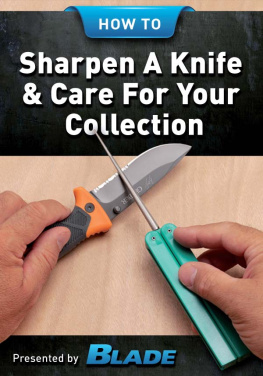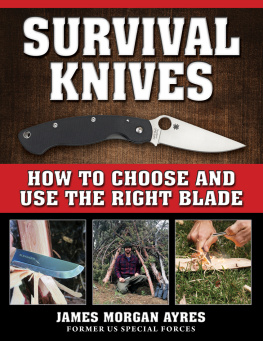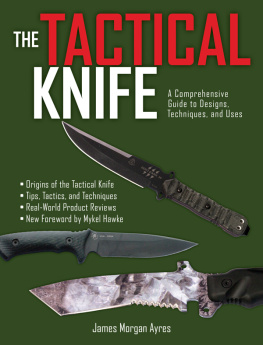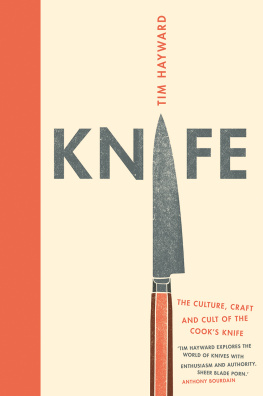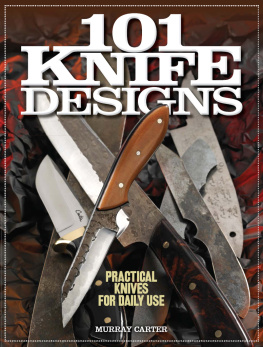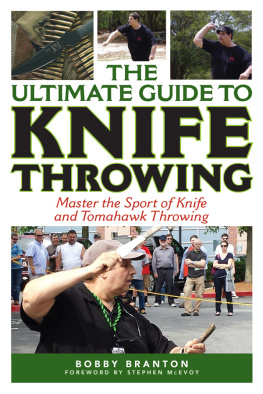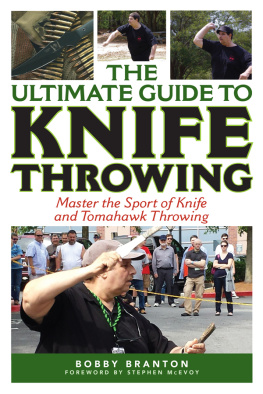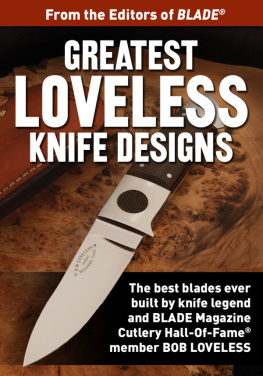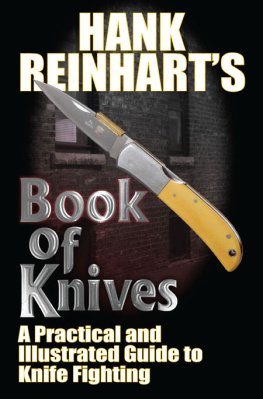Contents
CHAPTER ONE
Hones Of Stone
by Joe Kertzman
CHAPTER TWO
No Rust for the Wary
by James Morgan Ayres
CHAPTER THREE
Freehand Sharpening
by Dexter Ewing
CHAPTER FOUR
The Pros Favorite Sharpeners
by Durwood Hollis
CHAPTER FIVE
Lubed, Oiled, Greased and Bladed
by Joe Kertzman
CHAPTER SIX
Wedge Your Edge
by Dexter Ewing
CHAPTER SEVEN
Sharpeners Shape Up Knives
by Mike Haskew
CHAPTER EIGHT
Gramps Wasnt Far Off After All!
by James Morgan Ayres
CHAPTER NINE
Leave No Hone Unturned
by Joe Kertzman
CHAPTER TEN
A Moving Experience
by Stephen Garger
CHAPTER ELEVEN
The Knife Users Best Friends
by Dexter Ewing

Even with Nathans Natural Honing Oil and a Lansky Natural Arkansas Benchstone, it remains an acquired skill that takes patience and time to hold the blade at an angle to the stone, and to maintain the bevel angle. The knife is a Spyderco Dragonfly Tattoo.
CHAPTER 1
Hones Of Stone
Numerous knife enthusiasts place their trust in stones for blade sharpening
By Joe Kertzman
Its one of the oldest methods of honing a blade bevel, the most traditional, conjuring up images of ancestors, grandparents, even Japanese bladesmiths working edges on whetstones or oilstones, fingers blackened from the grit. Stone remains a popular sharpening medium. It might not be the Stone Age, but you would hardly know it by perusing the rock-hard offerings of knife or knife sharpener and accessory companies.
Unlike traditional stones bought for pennies apiece at the old hardware store, the Smiths 2-Stone Sharpening Kit (www.smithsedge.com) comes with a 5-inch, medium-grit stone, a 4-inch fine Arkansas stone, honing solution and a sharpening guide. The medium-grit stone, meant for quickly setting an edge, comes mounted on a molded-plastic base that features a built-in storage area at the bottom for holding the fine Arkansas stone, the latter of which is ideal for finishing or polishing an edge. The manufacturers suggested retail price (MSRP): $15.99.
It is everything you need to put a razor-sharp edge on your large or small knives and tools, Richard Smith says. The neat thing about this kit is that, although you get two stones, they only take up the space of one bench-mounted stone. I never lose the fine stone because its always stored in the base, and it allows me to take the fine stone into the field with me if needed.
As long as a knife blade is flat ground, Smith says the 2-Stone Sharpening Kit will hone any alloy, carbon or steel. It will not sharpen serrations, he notes. There is not a blade length limit for the kit. However, when sharpening long knives you have to be more conscious of the size of the stone and adjust your sharpening stroke accordingly.
Always use honing solution or water as a lubricant when sharpening with stone sharpeners because it keeps the pores of the sharpener clear and clean, Smith adds. It dissipates frictional heat and facilitates a smooth sharpening action.
Natural Arkansas sharpening stones are known as the worlds best finishers when it comes to sharpening, he continues. They actually polish the cutting edge as the stone removes small metal particles from the blade. When used properly, they can finish the cutting edge in a more clean, consistent manner than other sharpeners.
The late Arthur Lansky LeVine, long-time owner of Lansky Knife, Tool & Sharpeners (www.lansky.com), once gave his own lesson on Arkansas stones. The correct terminology is novaculite, he said. What makes a novaculite stone so unique is that, unlike aluminum oxide or silicon carbide, which either cuts or polishes, the crystalline structure of novaculite does both. Thats what makes the stones so desirable.

The W.R. Case & Sons V-Sharpening Kit features two soft Arkansas stones on wooden shafts that fit into a wooden base so that, when in position, the stones are in a vertical V formation. The knife is an engraved Glenn Marshall K-II-2B Hunter.

GATCOs No. 80005 Natural Arkansas Sharpening Kit contains a wood-block-mounted, 5-inch natural Arkansas stone, a 3-inch fine stone, angle guide, honing oil and a plastic storage case.
A God-Given Gift
No matter if its an Arkansas stone or a carborundum [silicon carbide] stone, the manner of using them is the same, LeVine imparted. Its a God-given gift to hold the blade at an angle to the stone, and to maintain the bevel angle. Thats why the Lansky fixture sharpener was invented, but we also cater to people who are old school, and who are used to using a benchstone.
In addition to knives, Lansky Natural Arkansas Benchstones are ideal for honing chisels, planer blades, axes and large tools. They come in two sizes, 6x2 inches and 8x2 inches, and are recommended for use with Nathans Natural Honing Oil, also offered by Lansky. The stones come in slip-proof plastic bases. The MSRP: $20 each.
Common to all benchstones, when you hone, you create metal filings. Oil or water suspends the old filings, LeVine explained. Lightweight mineral oil or even cooking oil is sufficient for suspending the metal filings and particles, and making the stone easier to clean. People will take a rag, and if they dab the surface of the stone, it will lift the filings out, but if they run the rag across the face it will clog the pores.
Much like the ceramic V or fixture sharpeners that Lansky helped popularize, the W.R. Case & Sons V-Sharpening Kit (www.wrcase.com) features two soft Arkansas stones on wooden shafts that fit into a wooden base so that, when in position, the stones are in a vertical V formation. In fact, Fred Feightner, consumer marketing and communications manager for Case, says, Its much the same way you might see ceramic sticks arranged. The MSRP for the kit: $34.99.
After adding a few drops of oil to the stones, and spreading it across the surface so that the blade will glide along more easily, the user simply holds a knife, blade edge down, perpendicular to the base, as if one were going to cut a slice of cheese, Feightner instructs. You start sharpening at the top end of one stone, applying pressure while drawing one blade bevel against the stone face within one side of the V in a downward motion toward you.
After a few strokes on one blade bevel, the process is repeated on the second blade bevel inside the opposite arm of the V, and each step is continued until the desired cutting edge is attained.
The solid-wood construction and flat base design give you added stability and additional safety while honing, Feightner says. The blocks are set at just the right angle for honing almost any Case knife to near-factory specifications. The soft Arkansas stones work great on all of our stainless or chromium-vanadium blades.

The Smiths 2-Stone Sharpening Kit comes with a small, plastic angle guide that can be placed on the stone. The face of the blade is rested on the guide for the first few times a user hones a blade and until he or she becomes accustomed to holding an angle. The knife is a fileworked Pete Truncali folder.

